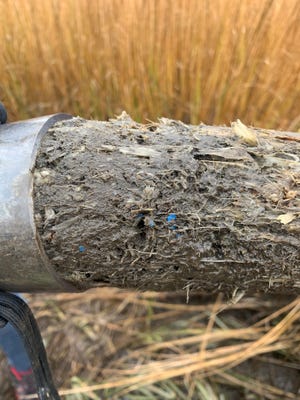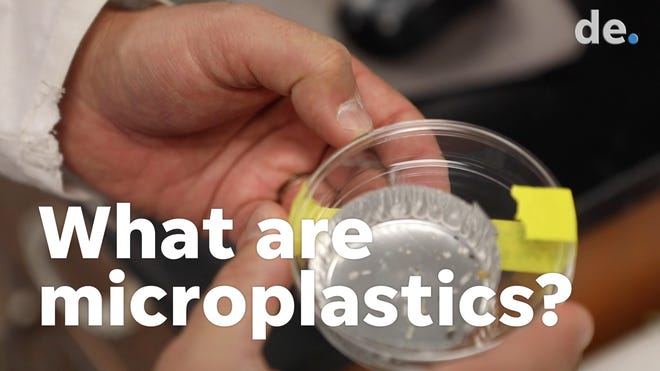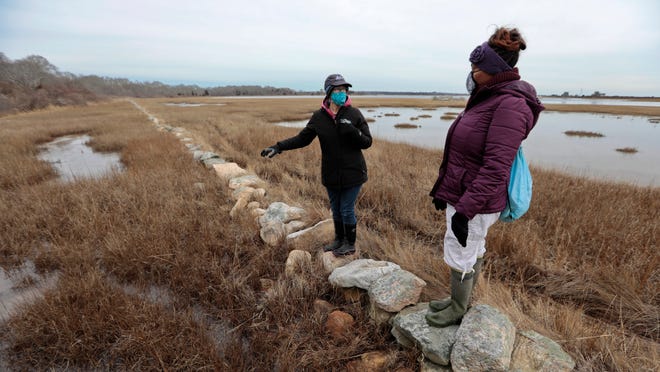NEW BEDFORD — Walk by a salt marsh and you’ll see tall grasses, a glassy water surface and perhaps a few local bird species. By sight alone, the marsh may appear to be in its natural state.
According to a new study, though, some marshes — built up for years and years by layers of sediment — contain countless plastic fragments and fibers under their surfaces, some so tiny they’re only visible through a microscope.
Javier Lloret, a research scientist at the Marine Biological Laboratory in Woods Hole and a lead author, said the study is the first step in considering what implications microplastics have for salt marshes.

“Humans are the ones producing these plastics that ultimately will break up into little tiny pieces, become microplastics and contaminate our environment,” Lloret said. “So one of the hypotheses that we started with was the idea of, if you have more people living in an area, if the area is more densely urbanized, the salt marshes in that area are going to have more microplastics in the sediment. It makes total sense from a common sense point of view, but it had not been tested yet.”
And that’s what they found: the more urbanized the surrounding land was, the more microplastic fragments they found in the salt marsh sediment.
For the study, researchers took sediment cores from salt marshes in Cape Cod and New Bedford. Each marsh had a different level of watershed development and population density, with the New Bedford site being the most urbanized.
Keeping the environment clean:Volunteers collect trash in Fairhaven. Next, they’ll mail some back to the companies.
While they found microplastic fragments and fibers in all sampling sites, they found a link between the number of fragments and level of urbanization. Specifically, the abundance of microplastic fragments in sediment samples increased as the degree of urban development on adjoining land increased.
What was consistent across sites, though, was the amount of microplastic fibers — the material released from synthetic clothing or fishing gear. Regardless of the level of urbanization, fibers were equally abundant in the samples, Lloret said.
Due to this distinction, Lloret believes fragments have a local source, whereas fibers may be sourced from the region as they can be transported more easily by wind or water.
Reconstructing the history of microplastics
At two of the Cape Cod sites, the scientists took deeper sediment cores to trace when plastic started appearing in the salt marsh.
About 30 centimeters deep took them to the early 1940s, Lloret said, when plastic was rare and not widely used. While studying the cores, they found the number of microplastics increased dramatically closer to the surface.
Salt marsh restoration:Climate change creates stress for homeowners battling erosion on Cape Cod
“In the last 25 years, the number of [plastic] particles you find in the sediments was doubled,” he said. “If we continue these trends, in just a matter of another decade we can have a lot more microplastics, and the impacts that we’re still trying to figure out can be even worse.”
What does this mean for salt marshes?
Salt marshes are important ecosystems. They provide habitats for numerous species (including shellfish some people enjoy eating), protect coastlines against storm surges and sea level rise, and sequester carbon, Lloret said.
They also act as effective “sinks,” with the grasses capturing materials — be it plant matter, dirt or plastic — and depositing it on the base of the marsh.
‘Drowning in place’: Mass Audubon begins work to protect Dartmouth salt marsh
Lloret said this study was just the first step. It confirmed salt marshes contain microplastics and that levels are linked to human activity. However, the “million dollar question” that remains is what the presence of microplastics means for the health and functionality of the ecosystem.
Filter feeders like mussels and clams don’t differentiate between a particle of food or a microplastic, Lloret said. If they consume plastic, it can affect their health as well as that of human consumers.
“I’m very interested in the effects that it’s going to have in the food web, because those food webs are responsible for the functioning of the entire ecosystem,” he said. “That’s the kind of direction that I would like to go with this.”
Until he and other researchers untangle those big questions, Lloret said municipalities and the state can consider actions, such as educating residents on recycling or establishing regulations that bar certain synthetic materials.
The bottom line, though, is trying to use less things that are made of plastic, he said.
Standard-Times reporter Anastasia E. Lennon can be reached at alennon@s-t.com. You can follow her on Twitter at @aelennon1. Support local journalism by purchasing a digital or print subscription to The Standard-Times today.


